The Top 20 NBA Draft Prospects in the Pac-12 Conference
The Top 20 NBA Draft Prospects in the Big 12 Conference
The Top 10 NBA Draft Prospects in the AAC Conference
The Top 22 NBA Draft Prospects in the SEC Conference
The Top 10 NBA Draft Prospects in the Big East Conference
The Top 20 NBA Draft Prospects in the Big Ten Conference
Top NBA Prospects in the ACC, Part 1
(#1) Jahlil Okafor (Scouting Video)
Top NBA Prospects in the ACC, Part 2
(#2) Justise Winslow (Scouting Video)
Top NBA Prospects in the ACC, Part 3
(#3) Montrezl Harrell (Scouting Video)
Top NBA Prospects in the ACC, Part 4
(#4) Tyus Jones (Scouting Video)
Top NBA Prospects in the ACC, Part 5
(#5) Brice Johnson (Scouting Video)
Top NBA Prospects in the ACC, Part 6
(#6) Marcus Paige (Scouting Video)
Top NBA Prospects in the ACC, Part 7
(#7) Theo Pinson
(#8) Justin Jackson
(#9) Terry Rozier
(#10) Jerian Grant
(#11) Kennedy Meeks
Top NBA Prospects in the ACC, Part 8
(#12) Rasheed Sulaimon
(#13) Mike Tobey
(#14) Cat Barber
(#15) J.P. Tokoto
(#16) Wayne Blackshear
Top NBA Prospects in the ACC, Part 9
(#17) Chris McCullough
(#18) Malcolm Brogdon
(#19) Joel James
(#20) Olivier Hanlan
(#21) Aaron Thomas
#22, Quinn Cook, 6'1, Senior, PG, Duke
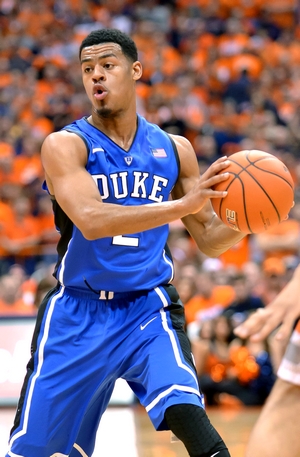
Derek Bodner
Quinn Cook spent his freshman season backing up Austin Rivers and Seth Curry, but came into his own in a major way during his sophomore season. During his second year, Cook saw his minutes jump from 11.7 to over 33 per night, contributing 11.7 points and 5.3 assists on a deep Blue Devils team.
While Cook may not have made the same statistical leap in his junior season, at least in terms of per-game stats, his overall efficiency and pace adjusted stats continued to trend in the right direction. His points per 40 minutes pace adjusted increased slightly, from 13.9 to a career-best 15.6, while his efficiency rose, producing a true shooting percentage of 57.1%, a considerable improvement over the 52% he shot in his previous two seasons at Duke.
Cook made a huge jump in his proficiency from the perimeter during his sophomore season, and this continues to represent a big portion of his offensive game. Cook shot only 25% (in limited attempts) from three point range during his freshman year, but that jumped up to a very impressive 39.3% on 3.9 attempts per game during his sophomore season. While not quite as prolific, Cook shot 37.1% on over 5 attempts per game during his junior year, which further reinforces that the improvement he showed during his sophomore year was legitimate.
Cook remains very effective shooting off the catch, connecting on a very good 38.9% in these situations, which due to the majority of these attempts being beyond the three point line yields an impressive 1.167 points per possession. Cook maintains a good shooting pocket before the pass, and has a compact shooting motion that allows him to get the shot off fairly quickly.
Where Cook did make strides this season is shooting off the dribble, one area where struggled during his sophomore year, despite the overall improvement in his shot. Cook shot only 25.9% when shooting off the dribble during his second season, but improved that considerably, connecting on 36.6% during his junior year. Cook does a much better job of getting his feet set and maintaining good balance on these shots. With how much Cook operates in the pick and roll, this was a very important development in his game.
Still, Cook's primary threat off the pick and roll is as a passer. Cook has very good instincts as a passer, and makes good reads with the basketball, able to see a play before it develops. While not one to necessarily look for the flashy or high-risk pass, although Cook is capable of displaying impressive court vision and creativity at times, Cook's real gift as a passer is being able to deliver the ball on time and at the right spot. Rarely are Cook's passes off target, allowing his teammates to make take their shots in rhythm.
Cook also shows some ability getting to the rim off the pick and roll. While not an explosive athlete, either in terms of his first step or explosion in the lane, Cook is very quick with the ball in his hands, thanks in large part to the excellent control he has with his dribble. With the ability to come around the edge quickly, as well as the ability to change direction on a whim, Cook is able to get by his man and into the paint. While his size, strength, and being a largely below the rim player limits Cook somewhat as a finisher in traffic, he does have good body control and touch with either hand around the hoop.
On the defensive side of the court, Cook's short stature, without the huge wingspan or reach to make up for it, are sure to be factors limiting his overall contributions on this end of the court at the next level. Still, Cook plays a tenacious pressure defense away from the hoop that cause some offensive players fits. Cook likes to press his man all the way out to half court at times, and has the foot and hand speed to be disruptive doing so. He also does a fairly good job of fighting through screens for a guy his size, and does a good job of denying his man when playing off the ball. While Cook's physical profile presents some concern on the defensive side of the court at the next level, his struggles will not be due to effort or focus.
Overall, Quinn Cook continues to hone his skills and mature into a well-rounded point guard. Cook has had the benefit of playing with many talented players around him, and it will be interesting how he, and the Blue Devils offense, transitions their offense from being centered around Jabari Parker and Rodney Hood to one based around a very different offensive big man in Jahlil Okafor. Similarly, it will be interesting to see how his role evolves this season with the addition of Tyus Jones, who was considered the best point guard in his high school class and is certain to push for major minutes as a freshman. While Cook lacks the elite physical tools for his position that many in the NBA are looking for, his well-rounded, controlled floor game and pressure defense may garner him looks come next June.
#23, James Robinson, 6'3, Point Guard, Pittsburgh, Junior
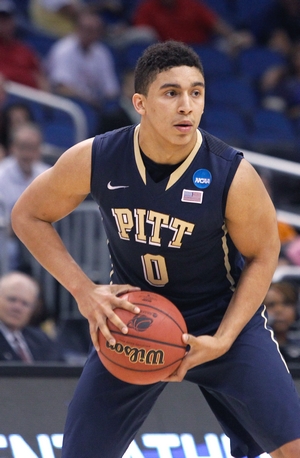
Kyle Nelson
James Robinson arrived on campus as a highly regarded high school recruit, coming from the storied Dematha program and being one of 12 players elected to represent USA Basketball at the Nike Hoop Summit. He wasn't particularly assertive in his first two seasons of college basketball, as he has helped Pittsburgh to consecutive NCAA Tournaments, but has been neither a prolific, nor efficient scorer. Now that Lamar Patterson and Talib Zanna have graduated, Pittsburgh needs to replace their production and leadership and Robinson is a prime candidate to pick up the slack.
Robinson has good size for the point guard position, standing 6'3 with a solid 203-pound frame. Robinson is just an average athlete, however, lacking standout quickness and explosiveness, which visibly affects him in different areas of his game. He is able to compensate somewhat at the collegiate level, but factoring his 6'3 wingspan in with his subpar athleticism means that he will likely be at somewhat of a disadvantage physically compared with most NBA guards.
On the offensive end, Robinson averaged just 10.5 points per 40 minutes pace adjusted as a sophomore, similar to the year before, which situated him among the least prolific scoring point guards in our database. His low usage rate tells part of the story, but so too does his poor 43% 2P%. While he is not the most aggressive offensive player, he does find his possessions in a diverse number of play types as Pittsburgh's primary facilitator.
In the half-court, Robinson is primarily a jump-shooter, seeing the biggest share of field goal attempts coming outside of the paint, and making 34% of his 3-point attempts. On film, his mechanics did not look particularly bad, as he possesses solid mechanics and a quick release and is actually a solid shooter in catch-and-shoot situations, to the tune of 39.2%. Developing his ability to shoot off the dribble would go a long way in increasing his efficiency on offense, as he converted just 30% of his pull-up jumpers last season, which is a skill he'll need to have in the NBA considering his lack of quickness.
Ultimately, however, Robinson is just not a great shot creator at this point in his career, as he rarely gets all the way to the basket in the half-court, and struggles to finish once he does, making just 42.1% of his overall attempts around the basket. He lacks creative ball-handling skills, and a quick first step, and hesitates to use his left hand. On film, Robinson is a decidedly below the rim player, without the length or body control to compensate. While he does a good job of drawing contact with his strong frame, he struggles to finish in traffic, and does not get to the free throw line at a great rate.
While Robinson is a decidedly below average scorer, he is a remarkably efficient and unselfish point guard, with a 4.11 assist/turnover ratio that ranks fifth among all players in our database. On film, Robinson is not a particularly creative passer, but he shows solid court vision in transition and plays under control and at a measured pace in Pittsburgh's half-court offense. He does a good job of finding teammates out of the pick-and-roll, as well, especially when it comes to finding open shooters off of the dribble.
With Pitt's primary offensive facilitator, Lamar Patterson off to the pro ranks, we'll likely see Robinson in a more traditional point guard role this season and one that may be closer to what will be expected of him at the next level.
On the defensive end, Robinson shows solid effort, toughness, and awareness that allow him to compensate somewhat for his lack of length and decidedly average lateral quickness. Likewise, he is a very aggressive player, not afraid to draw contact or chase loose balls, and he plays with active hands, which allow him to grab an impressive 2.0 steals per 40 minutes pace adjusted. Yet, he will undoubtedly struggle to stay in front of quicker guards at the next level and, without a consistent scoring arsenal to offset his limited defensive ceiling, it remains to be seen whether he can convince scouts he is worthy of consideration at the next level.
Though Robinson's NBA prospects are not particularly bright at this point in his career, his role in Pittsburgh's offense was to facilitate an offense built around a trio of veteran players, and he performed admirably. While he is not a prolific shot creator, he also was not required to look for his own shot and found many of his looks as a secondary option or after a play had already broken down. Thus, there is a good chance that Robinson will look very different as a junior. Becoming a better shooter and shot creator, more generally, is essential, however, as his physical limitations significantly affect his ceiling at the next level. With Pitt looking to rebound after a disappointing March, expect Robinson to be a key contributor for Jamie Dixon and the Panthers.
#24, Justin Anderson, 6-6, Junior, Small Forward, Virginia
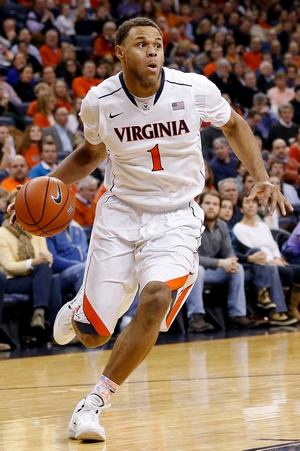
Matt Williams
After a solid freshman year in 2013 where he averaged 7.6 points and 3.3 rebounds, Justin Anderson's sophomore season brought much of the same. Posting season averages of 7.8 points and 3.2 rebounds, albeit in fewer minutes than he played as a freshman, Anderson's production stagnated somewhat, but he played a key role for a Virginia team that won 30 games and came up just short of the Elite Eight. With Joe Harris moving on to the pros, this season figures to be a pivotal one for Anderson, as there's room for him to have a breakout year for Tony Bennett's Cavaliers.
Despite his limited progression over the last year, Anderson remains intriguing thanks to his tremendous physical tools. At 6'6, Anderson has looked the part of an NBA player since he was a high school freshman, thanks in no small part to his strong 225-pound frame and 6'11 wingspan. On top of his size, Anderson is a terrific athlete with great overall strength and explosiveness for a wing at any level.
The challenge for Anderson over his first two seasons at Virginia has been translating those tools into consistent production on both ends of the floor. The team's fourth leading scorer a year ago, Anderson has functioned primarily as a jump shooter in Virginia's methodical half-court offense, also contributing with his athleticism attacking closeouts and finishing in the open floor. Good for double-figures some nights but not much in others, Anderson's sophomore year largely reinforced what we wrote about him a year ago.
Perhaps the best evidence of that came in Anderson's shooting numbers, where for the second straight season, he made a passable, but far from impressive 32.1% of his perimeter jump shots in the half court. Accounting for around 60% of his total shots attempts, Anderson gets good elevation and has fairly fluid mechanics, but struggles to get dialed in from beyond the arc at times, whether he's spotting up or running off screens, which in Tony Bennett's system, can make it difficult for him to get comfortable on the offense end some nights.
Almost an identical observation can be made about Anderson's shot creating ability and finishing numbers, as he remains a limited ball-handler and has shot 50% around the basket in both of his collegiate seasons. Getting tunnel vision and looking out of control at times, Anderson's strength and explosiveness allow him to finish impressively on occasion, but as is the case with his offensive game on the whole, his consistency leaves something to be desired.
Despite the stagnation in Anderson's numbers, he did make some positive strides a season ago, appearing more comfortable with the speed of the college game and forcing fewer difficult shots. Though his assist numbers fell, Anderson still showcased his unselfishness and willingness to find the open man in the half court, two positives that should benefit him at the next level should his skill level continue to progress.
Where Anderson has the most obvious value at this stage in his career is on the defensive end. Though Tony Bennett's team was one of the best defensive units in the country, Anderson stood out at times regardless, as his shot blocking and versatility made for some truly impressive moments. An active defender with good lateral quickness and strength, Anderson still has an occasional lapses in positioning, but is able to defend multiple positions and seems to have plenty of promise on this end of the floor.
Looking ahead, this will be a key season for Anderson as a prospect, as he'll have an opportunity to get more playing time and show he can take on a bigger role than he displayed his first two years at Virginia. If he can show improvement as a shooter or shot creator, he could emerge as a viable draft candidate down the road.
#25, Rakeem Christmas, 6-9, Senior, PF/C, Syracuse
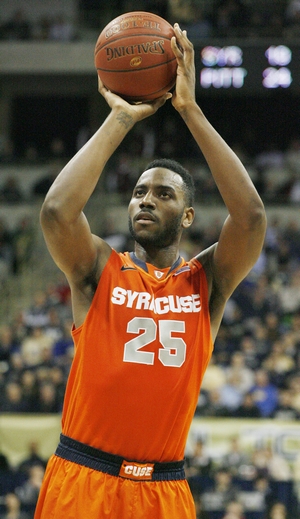
Jonathan Givony
A Mcdonald's All-American three and a half years ago, Rakeem Christmas' career at Syracuse hasn't really evolved the way some may have hoped. Despite being one of the oldest players in his high school class (he turns 23 in December), Christmas barely played as a freshman and then followed that up with two relatively non-descript seasons, averaging around 10 points per-40 with average rebounding numbers to boot.
While Christmas hasn't developed into a prolific scorer (his 10.8 points per-40 was lower than any college player drafted last season, and his overall usage rate is miniscule), he's managed to at least become a more efficient offensive player, upping his 2P% from 53 to 61% as a junior and his free throw percentage from 57 to 73%. Still, he's largely a non-factor offensively, with a 12% usage rate that would rank dead last among any player drafted in the past 13 years, showing just how rarely he touched the ball for Syracuse in his 24 minutes per game this past season.
Not a very skilled big man, Christmas sees most of his offense by crashing the glass, diving to the rim on cuts and pick and rolls, and mixing in the occasional post-up for good measure. He lacks the lower body strength or footwork to be overly effective with his back to the basket, as he doesn't possess great touch and is relatively passive looking to assert himself, but can be very dangerous when catching the ball in the immediate vicinity of the rim.
He ranked as one of the best finishers in college basketball last season, converting an outstanding 73% of his attempts around the basket, thanks to his tremendous length and very good leaping ability, allowing him to elevate and convert plays from impressive distances. Unfortunately Christmas saw less than two opportunities per game in these situations, despite playing next to one of the best passers in the country in Tyler Ennis (and Michael Carter-Williams the year before).
Outside of catching and finishing, there isn't much to speak of regarding Christmas' contributions offensively. He doesn't show enough intensity running the floor to be much of a factor in transition for Syracuse (scoring 4 points all season according to Synergy), he rarely draws fouls, and he hasn't shown much range on his jump-shot beyond 10-12 feet.
Defensively, Christmas has nice tools with his terrific 7-4 wingspan which allows him to play bigger than his 6-9 height, and very good athleticism to boot. He sits at the back of Syracuse's trademark 2-3 zone and rarely strays very far outside of the paint, being tasked with protecting the basket, which he does very well.
Christmas blocks shots at a high rate, as his 3.6 blocks per-40 would rank sixth best among returning Top-100 prospects if he was deemed as such. He uses his length very effectively to contest shots around the paint and sometimes on the perimeter when forced to make a closeout, as he's very mobile and quick off his feet.
Christmas' lack of size and lower body strength works against him at times, as opposing teams often looked to post him up as a way of attacking Syracuse's zone. He struggles to hold his ground at times and will give up deep post-position in turn, something that would likely be more of an issue against higher level competition operating as an undersized center like he has throughout his career thus far.
Christmas chases a lot of blocks, which puts him out of position on the glass, one of the reasons he averaged just 5 defensive rebounds per-40 minutes last season, a very poor rate. However, he also doesn't show great instincts for pursuing loose balls, often looking content just standing around flat-footed when rebounds come off the rim, as he doesn't appear to have the highest motor around. He's been a relatively poor rebounder his entire college career, which is not ideal considering how limited a player he is offensively already.
After four years of sitting inside the paint and protecting the basket as part of Syracuse's zone, Christmas will be at somewhat of a disadvantage relative to his counterparts transitioning to professional basketball as he attempts to learn how to operate in man to man settings virtually from scratch. Can he guard power forwards on the perimeter? How would he fare in different pick and roll schemes? These are all total unknowns for NBA decision makers and coaching staffs, which won't help his cause.
With that said, after starting over 100 games at Syracuse, Christmas will be one of the most experienced players in the ACC, and it will be interesting to see what kind of role he plays this season on a team that is in somewhat of a rebuilding phase. With no Tyler Ennis, C.J. Fair, or Jerami GrantSyracuse's top three scorers last year- someone will need to step up and play a much bigger role for the Orange offensively, and Coach Jim Boeheim has already gone on the record saying Christmas will be the most improved player in the conference. This is a big year for Christmas, as he has one last chance to show that he wasn't such a highly touted player in high school for nothing, and after losing quite a bit from last season, Syracuse will need all the help they can get from him.
#26, Boris Bojanovsky, 7-3, Junior, Center, Florida State
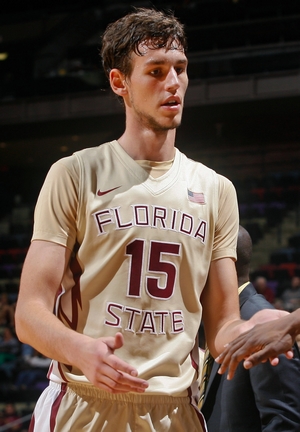
Josh Riddell
Coming from Slovakia to Florida State, Boris Bojanovsky has had two solid, but unspectacular seasons with the Seminoles. Coming back for his junior season, he will look to improve on his skill set both to help the Seminoles back to the NCAA tournament as well as make a name for himself within NBA circles.
Bojanovsky saw a modest rise in production from his freshman season, raising his per-40 minute pace adjusted level for points (10.3 to 11.4), rebounds (6.8 to 7.8) and blocks (2.7 to 3.6) while seeing an increase in minutes to 20.6 per game. He also became a more efficient player, seeing his field goal percentage jump from 54.7% to 58.8%. After taking a small step forward in his production, Bojanovsky will look for another jump in this year to become a much larger piece of the Florida State offense.
Physically, Bojanovsky has some excellent tools, as he has been measured at 7'3 with a nice wingspan and a frame that is slowly filling out. He isn't overly strong at 240 pounds and has room to continue to add muscle, but he has a nice base and isn't pushed around easily by other centers. He moves well for a player of his size, getting up and down the floor with nice mobility for a big man. His explosiveness is a bit lacking, which causes him to struggle to finish in traffic at times. Overall, he looks the part of a professional center and has some solid athleticism for a player his size.
On the offensive end, Bojanovsky was mostly used in post-up situations, where he showed some definite flashes of potential, but scouts will want to see him become more aggressive against collegiate competition. He demonstrated some nice post skills, including good hands, with his go-to moves being a strong drop step as well as an ability to move across the lane and shoot over his defender. He gains position well and is able to hold his ground, but struggles to get a good shot when he is pushed away from the rim and forced to back his man down. He also has a tendency to pass out quickly instead of looking to beat his man and although he is a capable passer, scouts will want to see him make better decisions as to when to attack and when to pass by being patient while reading the defense.
Bojanovsky was not a focal point of the offense other than the occasional post-up, and failed to contribute regularly on the offensive glass, pulling in a pedestrian 3.2 rebounds per 40 minutes pace adjusted. Although he has an impressive reach, he doesn't have the explosiveness, strength or toughness to consistently rebound in traffic. While he is a good finisher at the rim, 59.2% according to Synergy Sports Technology, many of these came on wide-open layup or tip in opportunities. In traffic, he struggled to get above the defense, which led to missed shots. Until he adds some upper body strength, allowing him to fight through the defenders, he may struggle to finish at the rim against NBA ready big men, which will be a red flag for NBA teams.
He has flashed potential in other offensive areas but will need to begin to show this potential on the court and round out his offensive game. His agility gives him some intriguing possibilities as a pick and roll player but he isn't a consistent enough screener, doesn't always show the awareness as to how to finish his cut after the screen and hasn't demonstrated a jump shot over a large enough sample to show he can be a pick and pop player. His jump shot form looks passable in the limited sample he has shown in his career so far and becoming a more effective pick and roll player, if Florida State chooses to incorporate it into its offense, will begin to show the role he can begin to fill in the NBA.
Defensively, Bojanovsky is still raw, but shows plenty of potential. He still struggles a bit with fouling, as he averaged 4.9 fouls per 40 minutes pace adjusted, due to his lack of strength compared to other big men. He struggles rebounding defensively as well, contributing only 4.6 defensive rebounds per 40 minutes pace adjusted. The only seven foot players in our database since 2001 that have averaged less than five defensive rebounds per 40 pace adjusted before being drafted were Ryan Kelly (2011 and 2013) and Alec Brown last season. Showing a more committed effort rebounding, especially defensively, will be a big step for him to take this season after two mediocre years in that area.
However, he uses his height to protect the rim, blocking 3.6 shots per 40 minute pace adjusted last season, one of the highest marks among centers. Continuing to do so in the ACC will show he can translate this skill and become a rim protector in the NBA, a skill many teams are looking for each season.
Bojanovsky still has a long way to go before becoming a viable draft prospect, but should have plenty of opportunity to show his development this season. His height will definitely keep scouts interested but he will have to show a more refined skill set as well as a better rebounding ability this season to keep their attention.













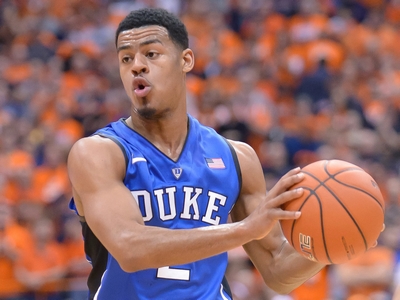




















Comments